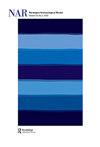Birds in the Bronze Age. A North European Perspective
IF 0.8
3区 历史学
0 ARCHAEOLOGY
引用次数: 0
Abstract
At a time when academics and people in general are becoming more and more distant from nature, there are now movements to bring back the relations with nature. In this sense Joakim Goldhahn’s book on birds in the Bronze Age is part of this development, to broaden our understanding of the relations with nature, which we as humans are a part of. Goldhahn’s aim in this book is to explore the relationships and the bonds between birds and humans during the Bronze Age as sets of mutual relations, and in his own words; ‘Yes, viewed from a relational ontology, the history of humans and birds are entwined’ (p. 7). However, his aim is more ambitious than this as he wants to question the distinction we draw between ourselves as human beings and other beings, as well as challenging the current mainstream Bronze Age studies of Northern Europe (p. 17–18). The book centres around three main themes: Lift-Off, Birdscapes and Intra-Actions. In addition, there are some important notes to the reader, a prologue, an epilogue and two appendixes. Goldhahn’s geographical focus is primarily the middle and southern parts of Norway and Sweden, as well as Denmark and Northern Germany – a scope which is natural considering his interest and thematic orientation. This is combined with a chronological framework from 2350–500 BCE, which he defines as the Bronze Age (p. xviii). In Part I – Lift off, Goldhahn uses ethnography, anthropological studies, bird divination in the ancient world and folklore to frame the importance of birds and their relations with humans in various settings, not to mention the many similarities between humans and birds (except flying). Theoretically Goldhahn places himself within the recent developments in the humanities and social sciences known as the ontological turn, challenging the Western dualism of nature vs. culture, and between humans and nonhumans. A perspective with no sharp distinctions in a relationship with nature, animals and objects. Here Goldhahn raises an important question not only for this book, but for archaeological research in general: ‘[...], for is it not the key purpose of archaeology to explore these speculations, other ways to know and explore the world, and, in the end, challenge our own understanding of the world?’ (p. 21). In other words, we need to learn about other people, how they perceive and comprehend the world in order to understand relationships materialized in the past. The spectacular and enigmatic MBA burial at Hvidegaard is here used both as a point of departure to develop birdscapes of the Bronze Age. In Part II – Birdscapes Goldhahn takes us to different contexts where we are introduced to birds in mediums such as bronzes, burials, settlements and rock art. His initial argument is that horse imagery in the Bronze Age was found in MBA II throughout LBA I, while bird imagery on the other hand, followed in the wake of this and is found in the first half of MBA III and throughout the rest of the Bronze Age (p. 97–99 and n.12). Goldhahn suggests that the form and the青铜时代的鸟类。北欧视角
在学术界和人们越来越远离自然的时候,现在有了恢复与自然关系的运动。从这个意义上说,Joakim Goldhahn关于青铜时代鸟类的书是这一发展的一部分,目的是拓宽我们对与自然关系的理解,我们人类也是其中的一部分。Goldhahn在这本书中的目的是探索青铜时代鸟类和人类之间的关系和纽带,作为一系列相互关系,用他自己的话说是的,从关系本体论的角度来看,人类和鸟类的历史是交织在一起的(第7页)。然而,他的目标比这更雄心勃勃,因为他想质疑我们作为人类和其他人之间的区别,并挑战当前主流的北欧青铜时代研究(第17-18页)。这本书围绕三个主题展开:起飞、鸟景和内部行动。此外,还有一些重要的读者注意事项,一个序言,一个结语和两个附录。Goldhahn的地理重点主要是挪威和瑞典的中部和南部,以及丹麦和德国北部——考虑到他的兴趣和主题取向,这个范围是自然的。这与公元前2350-500年的时间框架相结合,他将其定义为青铜时代(第xvii页)。在《第一部分——起飞》中,Goldhahn利用民族志、人类学研究、古代世界的鸟类占卜和民间传说来阐述鸟类的重要性及其在各种环境中与人类的关系,更不用说人类与鸟类之间的许多相似之处(飞行除外)。从理论上讲,Goldhahn将自己置于人文和社会科学的最新发展中,即本体论转向,挑战西方自然与文化以及人类与非人类之间的二元论。在与自然、动物和物体的关系中没有明显区别的视角。在这里,Goldhahn不仅为这本书,而且为整个考古研究提出了一个重要的问题:“[…],因为探索这些推测,了解和探索世界的其他方式,并最终挑战我们自己对世界的理解,难道不是考古学的主要目的吗?”(第21页)。换句话说,我们需要了解其他人,了解他们如何感知和理解世界,才能理解过去具体化的关系。Hvidegaard壮观而神秘的MBA葬礼在这里既是开发青铜时代鸟类景观的出发点。在第二部分“鸟景”中,Goldhahn将我们带到了不同的背景下,在这些背景下,我们被引入了青铜、墓葬、定居点和岩石艺术等媒介中的鸟类。他最初的论点是,青铜时代的马意象在MBA II和LBA I中都有发现,而另一方面,紧随其后,在MBA III的前半期和青铜时代的其他时期都有发现(第97–99页和第12页)。Goldhahn认为
本文章由计算机程序翻译,如有差异,请以英文原文为准。
求助全文
约1分钟内获得全文
求助全文
来源期刊

Norwegian Archaeological Review
ARCHAEOLOGY-
CiteScore
2.10
自引率
0.00%
发文量
13
期刊介绍:
Norwegian Archaeological Review published since 1968, aims to be an interface between archaeological research in the Nordic countries and global archaeological trends, a meeting ground for current discussion of theoretical and methodical problems on an international scientific level. The main focus is on the European area, but discussions based upon results from other parts of the world are also welcomed. The comments of specialists, along with the author"s reply, are given as an addendum to selected articles. The Journal is also receptive to uninvited opinions and comments on a wider scope of archaeological themes, e.g. articles in Norwegian Archaeological Review or other journals, monographies, conferences.
 求助内容:
求助内容: 应助结果提醒方式:
应助结果提醒方式:


